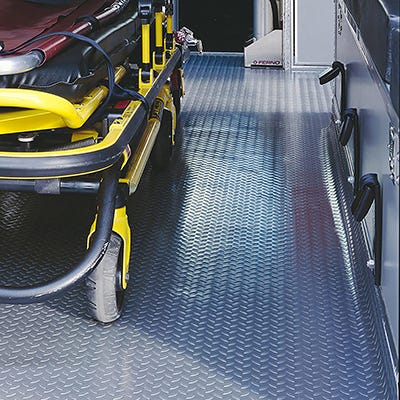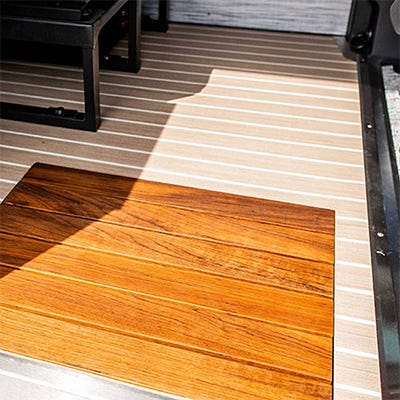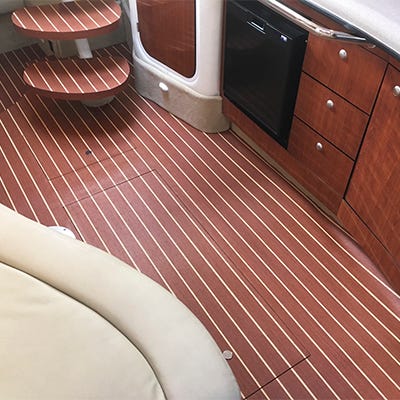

When you think of boat decks and floors, you probably think first of materials like fiberglass or aluminum finished with a non-skid treatment, classic teak or mahogany, cushy marine carpeting, or even the new crop of peel-and-stick foam decking materials.
But what about vinyl? You might be surprised to learn that sheet vinyl flooring has been in wide use on commercial and recreational boats and yachts for decades now. In fact, for many applications, sheet vinyl is superior to the alternatives. Here’s what you need to know:
Contents
Vinyl Excellence
Compared to foam decking and carpeting, sheet vinyl is extremely durable and easy to maintain. Designed for commercial applications like passenger airplanes, ambulances, hotels, restaurant kitchens and office buildings, this stuff can take a beating.
It is waterproof, flame-resistant, chemical resistant and abrasion resistant. It also cleans up quickly and easily with nothing more than a no-rinse pH-neutral cleaning solution and a microfiber mop.
Porous gel coat, wood, and foam decking are all more prone to absorbing chemicals and stains as well as harder to clean. All of that makes vinyl the marine flooring of choice for areas exposed to high traffic and/or lots of spills — engine rooms and other machinery spaces, bar and galley areas, heads, tender/water toy garages, passageways, ladders and bridges.
Choose Your Finish
You might think all commercial-grade flooring is going to look … well, commercial. And much of it does. But vinyl manufacturers like Lonseal in fact offer a huge variety of high-quality faux finishes that mimic traditional hardwood floors, strip decking and even stone.
In most cases, Lonseal actually photographs a “real” version of the finish to be duplicated and then transfers the photographic image to the vinyl flooring.
For example, in developing their Lonmarine Wood line, the company hired local craftsmen to make a 4-foot by 8-foot section of teak-and-holly decking on a sheet of plywood, photographed the decking and reproduced the image beneath the wear layer of their flooring.
Indoor/Outdoor Dynamics
It’s important to keep in mind that the majority of sheet vinyl flooring products are not designed for exterior use. In fact, Lonseal only offers one product line, Londeck, meant for permanent exterior use.
Lonmarine Wood, Lonmarine Stone and Loncommodore (a diamond-plate pattern), says the company, are “indoor/outdoor” products that can withstand years of sun exposure before eventually beginning to darken in color.
Keep in mind that the majority of sheet vinyl products are not designed for exterior use.
Whether Lonmarine is right for your exterior application, the company says, depends on where you do your boating and how you store your boat. If your boat lives year-round in an uncovered slip in Florida, Lonmarine is probably not the best choice for your cockpit decking. On the other hand, on a trailer-boat in Massachusetts that spends half the year shrink-wrapped and the rest under a pole barn, Lonmarine will last for many years.
Lonseal’s other sheet vinyl products — including Loncoin, Lonstrand, Lonwood, Lonplate and Lonridge, all of which Boat Outfitters carries — are meant for interior use only, including in salons, wheelhouses, galleys, heads, engine rooms, corridors, ladders, etc.
A Fraction of the Cost
As an alternative to real wood flooring/decking or even faux or synthetic teak products, sheet vinyl is extremely cost-effective.
Its low-maintenance nature also saves substantial maintenance costs versus real wood flooring. Not considering installation costs or the cost of adhesive, sheet vinyl is comparable in price to most peel-and-stick foam decking products.
All Business
True to its commercial application roots, most marine vinyl flooring offers essentially no cushioning. That’s not necessarily a bad thing; fiberglass, aluminum and wood aren’t cushioned either. But if you want something springy underfoot, go with a peel-and-stick foam product or marine carpet.
Lonseal does in fact offer closed cell foam padding meant to be installed under vinyl sheeting. The company doesn’t recommend it for marine applications, but at least one boat builder factory installs the padding with their vinyl flooring and has reported no issues.
Epoxy Installation
Vinyl flooring differs from peel-and-stick foam decking in that it is typically glued in place using a two-part epoxy adhesive. That’s easier than it sounds at first. The epoxy has a working time of around 15 minutes, allowing for fine-tuning after the vinyl has been laid down.
For DIY jobs, the process looks like this:
- Carefully prep the area to be covered.
- Use butcher paper to create a template.
- Trace the template onto the vinyl flooring and cut out with a sharp utility knife.
- Mix the adhesive and spread it over the area to be covered using a U-notch trowel.
- Lay the flooring onto the adhesive and use a heavy roller to push out air bubbles
- Roll again in 2 to 3 hours
Keep in mind that the material must be unrolled to “relax” at least eight hours before installation. Because it is rolled while heated, sheet vinyl will actually shrink in length and expand in width once off the roll. When tracing your template, the flooring should be at the same temperature it will be when it’s installed. In other words, if you cut your vinyl flooring to shape in a heated workshop and then take it outside to install on a 45-degree fall day, it won’t fit correctly.
Lonseal does offer a permanent tape as an alternative to epoxy adhesive, but it’s significantly more expensive.
All in the Prep
As is the case with just about any other decking or flooring product, careful prep work prior to installation is critical to performance. In the case of marine vinyl, it’s especially important to make sure the surface is smooth and table-top flat.
If one of your goals in installing flooring is to cover imperfections underneath — gouges, old fastener holes, protruding screw heads, etc. — sheet vinyl isn’t your best choice, since it will form itself to any irregularities over time.
Commonly Asked Questions
Vinyl flooring is smooth. Won’t it get slippery when it’s wet? That’s an easy assumption to make, but in fact, the answer is no. All of Lonseal’s products are ADA-approved for slip resistance and approved by the US Coast Guard and the International Maritime Organization. Even “smooth” sheeting like Lonmarine is lightly textured, and the company says that, surprisingly, it’s smooth products provide better wet tractions than its textured products.
What are the different textures for? Texture is largely a matter of preference; all of Lonseal’s textured sheet vinyl — Loncoin, Lonplate, Lonridge, etc. — is the same material with a different pattern stamped into the surface at the end of the manufacturing process. Lonridge, with its dirt-hiding flecked finish, is the company’s most popular product, followed by Loncoin II. Lonplate I is patterned after diamond-plated steel, while Lonplate II is a less aggressive version that’s more comfortable to stand on for long periods.
What does topseal mean in vinyl flooring? Topseal is a urethane coating applied at the factory that yields a glossier appearance and makes the material even easier to clean. If you’re trying to match varnished teak or mahogany brightwork, topsealed vinyl will come closer. On the other hand, many boaters prefer a more matte finish for flooring or decking.



